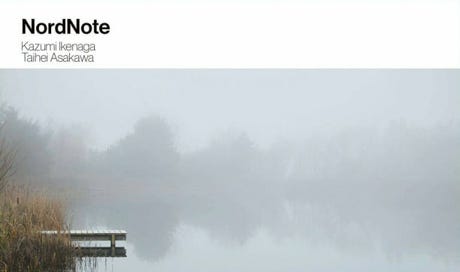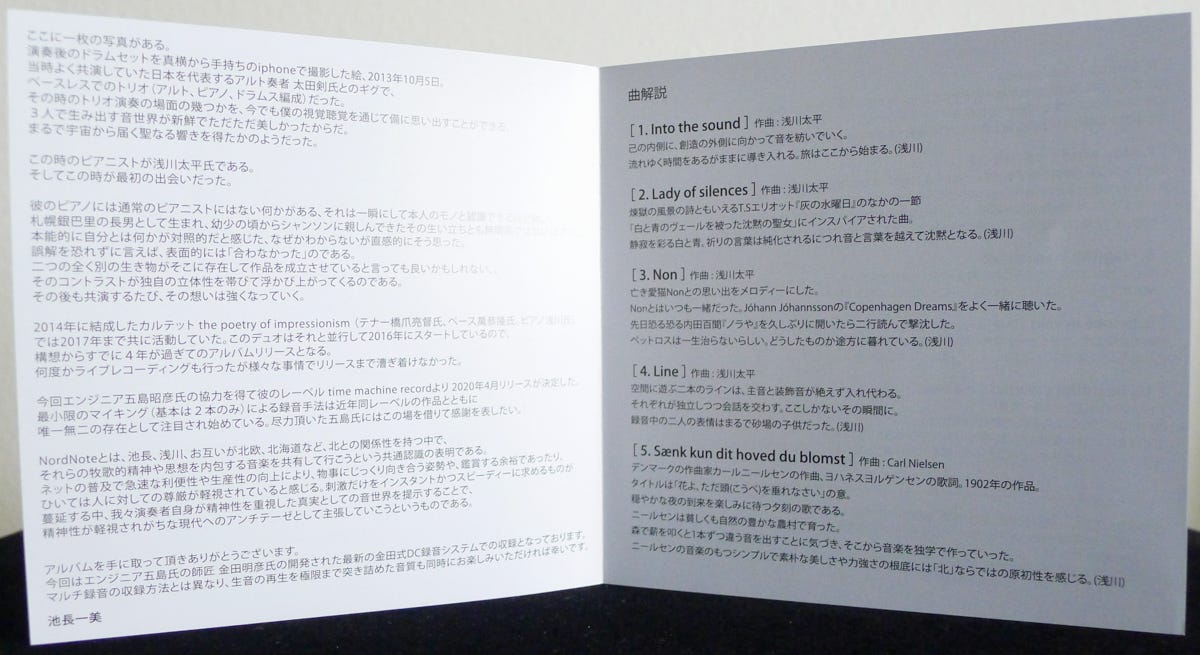Kazumi Ikenaga & Taihei Asakawa: NordNote
NordNode is a 2020 album from drummer Kazumi Ikenaga and pianist Taihei Asakawa, with ten tracks and fifty-five minutes of music performed with care, maturity, and a strong bond between the two musicians.
This album captures a directly connected musical conversation between drummer Kazumi Ikenaga and pianist Taihei Asakawa. A duo made up of drums and piano is not a very common format in jazz, but it is a format that really shows how, like with the circular yin-yang symbol, the two musicians fit perfectly together and fill out the space as if thinking, moving, and playing as one.
(As an aside, this duo format also provides a nice complementary subject to follow the previously introduced Yuki Ito bass solo album, as the three instruments complete the customary jazz trio format of piano, bass, and drums!)
Indeed, this drums and piano two-person format does allow for a great degree of listening and reacting by the pair as each player listens intently to the other. This makes the music seem like an extremely tuned-in conversation that naturally expands and flows, centered around each composition like both favorite and improvised topics to speak about.
On NordNote, these topics include seven evocative originals (six by Asakawa, one by Ikenaga) and three simply beautiful covers. Through it all, the overarching theme of nord (north) colors the canvas and directs the flow.
Ikenaga, like drummers Paul Motian and Jon Christensen, has an approach that expands the drumset much beyond straightforward time-keeping and common jazz patterns, turning the use of sticks, brushes, percussion instruments, and the whole set with artful silence and pauses like the negative space between words or in art. This all works excellently for creating substantial textures and upfront ambience through his melodic playing.
With pianist Asakawa, Ikenaga has a complementary and equal partner, one who fills out the songs’ natural melodic and harmonic parts like great lyrical players Bill Evans and Keith Jarrett. (To that point, Asakawa’s recent live solo recording Waltz For Debby summons the spirit of those famous Village Vanguard Bill Evans Trio live albums, and this album’s #9 “In Love In Vain” has the addictive swing feel of the Keith Jarrett Trio version of that song, quite a high bar to match.)
Much like melodic improvisation, the two musicians simultaneously decide how to keep time, play rubato, open up, add shading, pause, or build — a meeting of minds in concentration and creation. The typical roles even seem to be switched at times, when Asakawa’s piano keeps time steady and the Ikenaga’s drums, cymbals, and percussion sounds color in the spaces with softness and delicacy.
This amazing music does speak for itself, and words just scratch the surface of the art here. Suffice it to say it’s captivating music, patient and radiant, ethereal and tender, and a joy to listen to these two musicians create together. The following translated liner notes provide additional context and thoughts from the two musicians.
Liner Notes
(Translated from Taihei Asakawa’s and Kazumi Ikenaga’s original Japanese liner notes.)
I play the piano. I am always trying to create distance from myself. In the space between myself and my alter ego, I gaze upon melancholy and death.
Over there, the much-loved and respected Kazumi Ikenaga is playing the drums. His sound is full of miraculous colors and light.
At first glance, we may seem to contrast with one another. Still, we share a transparent lyricism based on a bedrock that is not just a direction or location, but a spiritual dimension that is north.
Reverence for that which is invisible and sacred. Looking without bias towards all that is creation. The harmonious primal nature of the forests and universe.
North quietens people. A silence that speaks to us from beyond. And we realize. Ultimately we want to become that sound itself.
Taihei Asakawa
There is a photo here.
It’s a picture I took with my iPhone from right beside the drum set after a performance on October 5, 2013. At the time, I was often performing in a bass-less trio (formed of alto, piano, and drums) with a leading Japanese also sax player, Ken Ota. I can still recall some of the scenes from those trio performances vividly through my eyes and ears. Three people created a world of sound that was fresh and absolutely beautiful. It was almost as if we received sacred reverberations from the universe.
The pianist at the time was Taihei Asakawa. And this was our first meeting.
There is something in his piano playing that is not found in others, something so strong that it can instantly be recognized as his own. Raised as the eldest son at the music club “Gin-Paris Sapporo”, he was familiar with chanson from his early years, which undoubtedly had something to do with his upbringing. I instinctively felt that there was something there opposite to me. I didn’t know why but I just had a hunch. If I may say so without fear of being misunderstood, on a surface level it was, basically, “not a good match”.
It could be said that two completely different beings exist somewhere in order to create something. That contrast emerges with a unique three-dimensionality. Since then, that feeling has grown stronger with every shared performance.
In 2014 I formed the quartet The Poetry of Impressionism (tenor sax Ryosuke Hashizume, bass Yasutaka Yorozu, piano Asakawa) and we performed together through 2017. Our duo formation started in parallel from 2016, so this album release has already been four years in the making since conception. Several live recordings were also made, but for various reasons these have not resulted in album releases.
In this case, through the cooperation of engineer Akihiko Goto, we completed this album release on his label Time Machine Record in April 2020. The recording method of using a minimal miking technique (basically only two microphones), along with other releases from his label, has begun to attract attention as a unique presence in recent years. I would like to take this opportunity to express my gratitude to Akihito Goto for his invaluable contributions.
NordNode is an expression of the shared understanding between Ikenaga and Asakawa, with their connections to the north, to Hokkaido and Northern Europe, and the music that envelops the pastoral spirit and ways of thinking of those regions.
Paired with the rapid increase in productivity and convenience arising from the spread of the internet, it seems that acts of close observation, the time to appreciate art, and even dignity towards people are being neglected. It’s a world where speedy, even instant stimulation is all that is demanded. As an antithesis to a world that tends to overlook spirituality, we the performers want to present a musical outlook that places importance on spiritual-oriented truth.
Thank you for picking up this album. For this occasion, the recording was made using the latest Kaneda DC recording system developed by Akihito Kaneda, engineer Goto’s mentor. I hope you enjoy the recorded sound (different from multi-track recording methods) that maximizes live sound reproduction with perfect sound quality.
Kazumi Ikenaga
[1. Into the sound] Composer: Taihei Asakawa
Within oneself, weaving sounds towards the outside of creation. Allow time to flow as it is. The journey begins from here. (Asakawa)
[2. Lady of silences] Composer: Taihei Asakawa
A song inspired by “The silent sister veiled in white and blue”, a passage from T.S. Eliot’s poem Ash Wednesday, which can be said to depict the landscape of purgatory. A white and blue that colors the silence.
As the words of prayer are further purified, they transcend sound and language to become silence. (Asakawa)
[3. Non] Composer: Taihei Asakawa
I composed a melody from memories of my dearly departed cat Non. Non and I were always together. We often listened to Jóhann Jóhannsson’s Copenhagen Dreams together.
The other day, I tentatively opened up Hyakken Uchida’s Nora Ya for the first time in a long time, and after reading just two lines, I sunk into depression. It seems that the loss of a pet is a wound that never heals. I’m at a loss for what to do. (Asakawa)
[4. Line] Composer: Taihei Asakawa
Two lines play in space as the tonic and the embellishment constantly switch places. Each independently converses with the other. There is only this moment in time. While recording, the pair’s expressions resembled children in a sandbox. (Asakawa)
[5. Sænk kun dit hoved du blomst] Composer: Carl Nielsen
A song by Danish composer Carl Nielsen with lyrics by Johannes Jørgensen. This work was created in 1902. The title means “Oh flower, lay down your head”. It’s a song of the evening, and looking forward to the coming of a peaceful night.
Nielson grew up in a poor agricultural area rich with nature. In a forest, he noticed that pieces of firewood of different lengths would make different notes when struck, and from there he taught himself to make music. The simple beauty and strength contained in Nielson’s music are rooted in those elemental qualities that are unique to the north. (Asakawa)
[6. Cirkus] Composer: Taihei Asakawa
A song composed imagining the progression in the far north of a circus troupe made up of Nordic animals of the future. A Scandinavian electronica style 19-beat dance in acoustic form. I admire Ikenaga’s energetic solo development, free and lively without straying from the song’s essence. (Asakawa)
[7. May wind] Composer: Kazumi Ikenaga
I often get sick when May comes around, so although it’s exciting when spring passes to summer, perhaps my body can’t keep up with the changes, and the balance of mind and body crumbles.
As I hurried off to work reluctantly, saying “See you later” to my mother who had forgotten herself, a gentle breeze blew by and caressed my cheek. I felt as if my mother from back then was calling to me. (Ikenaga)
[8. Fragility] Composer: Taihei Asakawa
Rather than actual facts, memories are filled with the longings and aspirations of each moment. Humans are fragile beings. Because we cannot arrive there, we must entrust them with expression. (Asakawa)
[9. In love in vain] Composer: Jerome Kern
In between recording sessions, we performed a beautiful posthumous standard by Jerome Kern. Despite the sigh-like lyrics, we decided to set the tempo at a slightly thrilling pace. (Asakawa)
[10. Beautiful dreamer] Composer: Foster
A posthumous piece by the American composer Foster. He completed it a few days before his death, and the manuscript was later discovered at his home.
During the Civil War years, Foster lost his income, his wife passed away, and he became addicted to alcohol. Perhaps he was trying to sublimate his fading life into a beautiful melody, as if to escape reality. (Asakawa)
Recording system used: Original system developed, designed, and manufactured by Akihiko Kaneda
Kaneda-style balanced DC current transmission microphone (SCHOEPS MK2) x 2
DPA 4006-TL x 2
Kaneda-style balanced DC current transmission recording unit
Audio interface RME Fireface UC
NordNote by Kazumi Ikenaga & Taihei Asakawa
Kazumi Ikenaga - drums
Taihei Asakawa - piano
Released in 2020 on Time Machine Record as TMCD-1020
Japanese names: Kazumi Ikenaga 池長和美 (Ikenaga Kazumi) Taihei Asakawa 浅川太平 (Asakawa Taihei)
Related Albums
Taihei Asakawa: Catastrophe in Jazz (2011)
Taihei Asakawa Trio: Touch of Winter (2013)
Kazumi Ikenaga: Niwatazumi (2017)
Taihei Asakawa: Waltz for Debby (2018)
Other Links
Audio and Video
Excerpt from “Sænk kun dit hoved du blomst”, track #5 on this album:










